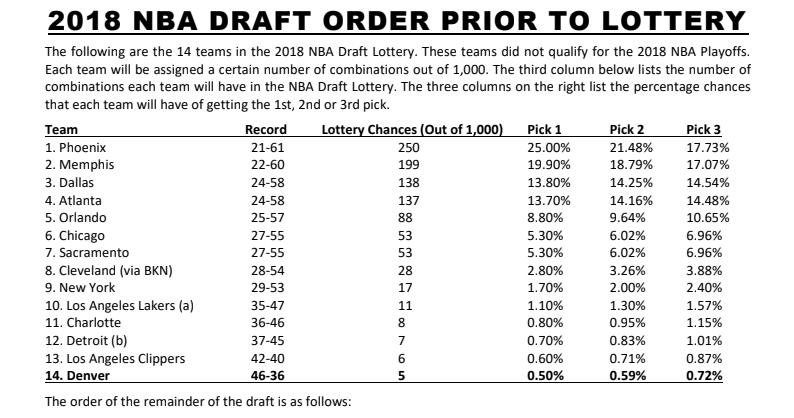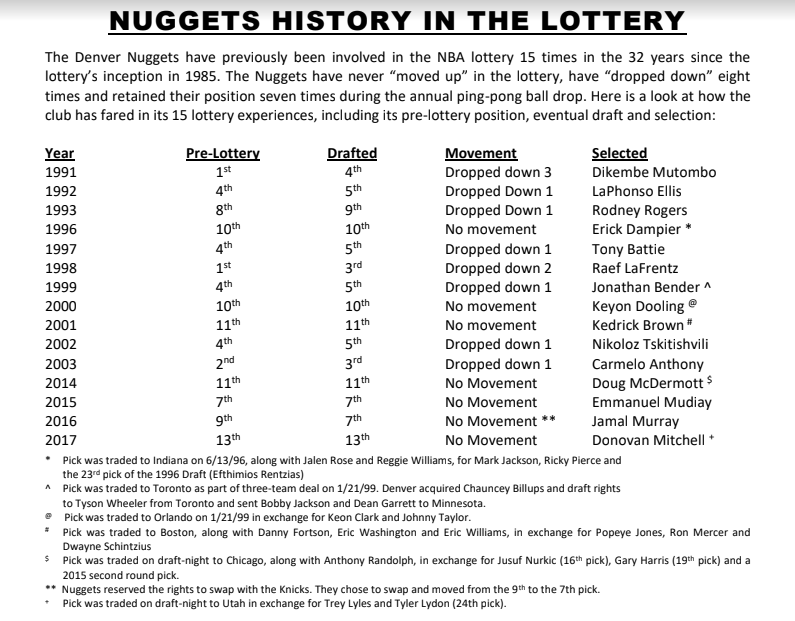© 2025 ALLCITY Network Inc.
All rights reserved.

How much can a couple of ping pong balls change a franchise’s outlook? Ask the Chicago Bulls.
In 2008, the Bulls had assembled a respectable core that included Ben Gordon, Luol Deng and Tyrus Thomas, who was a promising young player at just 21-years-old and heading into his third NBA season. But Chicago won just 33 games during the 2007-08 season and was still searching for the face of its franchise.
The Bulls entered the lottery with the ninth-best odds and a 1.7 percent chance at the No. 1 overall pick but struck gold. Chicago was awarded the first pick and a chance to choose between Kansas State’s Michael Beasley and Memphis’ Derrick Rose.
The Bulls chose right and selected Rose first overall. Rose won the league’s Most Valuable Player award in 2011 at just 22 years old, which made him the youngest winner in league history. Chicago made the playoffs in seven consecutive seasons and reached the Eastern Conference Finals in 2010-11 before injuries zapped the life out of Rose’s career.
Chicago’s blueprint — or Charlotte’s jump from 13th to 3rd overall in 1999 to select Baron Davis, which is still the most unlikely rise in draft lottery history — is what the Nuggets hope to follow Tuesday night. The Nuggets, who will be represented at the lottery by Jamal Murray, enter the evening with the worst odds to win the No. 1 pick or move into the top three.
The Skinny
Who: The 14 teams who did not make the NBA playoffs — Suns, Grizzlies, Mavericks, Hawks, Magic, Bulls, Kings, Nets (pick goes to Cavs), Knicks, Lakers (pick goes to 76ers if it lands at 1 or 6-14. If it lands at 2-5, the pick goes to the Celtics), Hornets, Pistons (pick goes to Clippers unless it falls 1-4), Clippers and Nuggets
When: Tuesday, May 15 2018 (5:30 p.m. MT, ESPN)
Where: Palmer House Hilton, Chicago, Illinois

How It Works –
Under the current rules, the first three picks are decided by the lottery system. After the first three picks are determined, selections 4-14 are slotted in inverse order according to their win-loss records from last season.
To determine the first three picks, 14 ping pong balls are placed in the lottery machine and mixed for 20 seconds before the first ball is removed. The remaining balls are then mixed in the lottery machine for another 10 seconds. The second ball is then drawn. Then, a 10-second mix before the third ball is drawn. Then, another 10-second mix before the fourth ball is drawn. The team that has been assigned that combination that the four lottery balls show will receive the No. 1 pick. The same process is repeated with the same ping pong balls and lottery machine for the second pick and then again for the third pick.
The Nuggets hold five out of the 1,000 possible lottery ball combinations. Denver has a 0.5 percent chance at the first overall pick, a 0.59 percent chance at the second overall pick and a 0.72 percent chance at the third overall pick. The Nuggets have a 1.8 percent chance of moving into the top three.
The Nuggets have been involved in the lottery 15 times. Denver has never moved up and has moved down on eight separate occasions. The Nuggets have retained their pre-lottery position seven times. The No. 14 pre-lottery slotted team has never moved up.

Biggest Lottery Night Movers
1990: Seattle jumps from No. 10 to No. 2 (3.6 percent chance) to select Gary Payton
1993: Orlando jumps from No. 11 to No. 1 (1.5 percent chance) to select Chris Webber
1999: Charlotte jumps from No. 13 to No. 3 (0.7 percent chance) to select Baron Davis
2006: Milwaukee jumps from No. 6 to No. 1 (6.3 percent chance) to select Andrew Bogut
2007: Portland jumps from No. 7 to No. 1 (5.3 percent chance) to select Greg Oden
2008: Chicago jumps from No. 9 to No. 1 (1.7 percent chance) to select Derrick Rose
2011: Los Angeles Clippers (pick went to Cleveland) jump from No. 8 to No. 2 (2.8 percent chance) to select Kyrie Irving
2014: Cavaliers jump from No. 9 to No. 1 (1.7 percent chance) to select Andrew Wiggins
ESPN’s Current Top-20
1. Deandre Ayton, Center, Arizona – Ayton is potentially a franchise-changing big man who can play both ends of the floor. At just 19 years old, he’s one of the most physically developed athletes to come into the draft at his age in some time.
2. Luka Doncic, Guard, Real Madrid (Slovenia) – Perhaps the best European prospect of all-time, Doncic has been playing at the highest level in Europe since he was 16. He’s one of the smartest players in the draft and can play either guard spot.
3. Marvin Bagley III, Power Forward/Center, Duke – Bagley is a high-level athlete, an elite rim-runner and will catch any lob thrown his way. He’s versatile on the offensive end of the floor but questions remain about his defense.
4. Jaren Jackson Jr, Power Forward/Center, Michigan State – One of the youngest players in the draft, Jackson can do it all. He can hit threes, finish around the rim and defend his position. Jackson has the chance to be the best big man in his draft class.
5. Mohamed Bamba, Center, Texas – At 6-foot-11 with an 8-foot wingspan, Bamba is a high upside play who may take a year or two to develop into a rotation-level player. He’s a huge lob target and could be one of the best rim defenders in the league in due time. Bamba averaged 3.7 blocks per game last season at Texas.
6. Trae Young, Point Guard, Oklahoma – Is Young the next Stephen Curry or Jimmer Fredette? Young is a bit shorter than Curry at 6-foot-2 but was just as electric last year at Oklahoma as Curry was at Davidson. He’s quick, shifty, isn’t as pure of a shooter as the two-time Most Valuable Player but similarly crafty.
7. Wendell Carter Jr, Power Forward, Center, Duke – Carter was a bit overshadowed by Bagley at Duke but make no mistake, league executives love what the big man has to offer. Carter can play inside and out and is a stout defender. He can also protect the rim and has an incredibly strong frame at just 19 years old.
8. Michael Porter Jr, Forward, Missouri – Porter’s missed most of his freshman season at Missouri because of a back injury that required surgery, and how he’s able to regain his athleticism will likely determine where he’s drafted next month. Before the injury, Porter was an expert scorer and the second-ranked recruit behind Bagley out of high school.
9. Collin Sexton, Point Guard, Alabama – High energy player with a competitive edge that coaches love, Sexton is an athletic guard who can play above the rim and thrives in space. Sexton didn’t score at a very efficient rate in college and scouts are a bit concerned about his decision-making and court vision.
10. Mikal Bridges, Small Forward, Villanova – Bridges is the second-rated wing behind Porter and projects as more of a two-way player than Porter, who has more of a scorer’s mentality. Bridges could potentially guard four positions at the next level and would fit with most teams looking for a versatile wing who can do a lot of things well.
11. Miles Bridges, Forward, Michigan State – Bridges shot a healthy 39 percent from three in his sophomore season at Michigan State and possesses a strong and defined frame at 6-foot-7, 225-pounds. He has the strength to defend power forwards but some scouts knock Bridges for his 6-foot-9 wingspan, which is a bit short for a player his size.
12. Shai Gilgeous-Alexander, Guard, Kentucky – At 6-foot-6, Gilgeous-Alexander has elite size and length at the point guard position and displayed a good understanding of playing in the pick-and-roll in college. He’s an improved shooter and flashed the tools to become an above-average defender last season at Kentucky.
13. Robert Williams, Center, Texas A&M – Williams is a tremendous athlete and lob target who projects as a plus-defender and shot blocker. His offensive game is a work-in-progress, however.
ESPN’s latest mock draft projects the Nuggets to select Williams 14th overall
14. Lonnie Walker IV, Shooting Guard, Miami – Walker is a great athlete with a gorgeous looking jumper but was a bit of a streaky shooter in college. He’s not a great ball handler and sometimes struggles to impact the game when his shot isn’t falling.
15. Kevin Knox, Forward, Kentucky – Knox has great size at 6-foot-9 for someone who will spend time on the perimeter at the next level but he’s far from a sure thing as a shooter right now. He hasn’t shown the ability to create his own offense and was inconsistent as a defender last year.
16. Zhaire Smith, Shooting Guard, Small Forward, Texas Tech – Smith is arguably the most athletic player in this draft class, has a high motor and a solid feel for the game. He didn’t shoot the three much in college, and that, along with his size at 6-foot-5, are his biggest question marks heading into the draft.
17. Aaron Holiday, Point Guard, UCLA – Holiday has a beautiful-looking shot and can get into the lane and make things happen on the offensive end of the floor. Can Holiday take care of the ball and defend consistently? Those are two question marks around his game right now.
18. Keita Bates-Diop, Forward, Ohio State – A rare, four-year college player, Bates Diop projects as a plus-defender who averaged 20 points for Ohio State last year and shot 36 percent from three.
19. Troy Brown, Shooting Guard, Oregon – Brown is a long, athletic wing who’s one of the best playmakers at his position in the draft. Questions remain about his ability to score the ball.
20. Dzanan Musa, Small Forward, Cedevita (Bosnia) – Besides Doncic, this year’s European class is weak compared to year’s past. Musa doesn’t possess a particularly long frame but is a gifted scorer. Scouts worry about his athleticism and defensive upside.
More BSN Nuggets Draft Content
Comments
Share your thoughts
Join the conversation



